|
|
Welcome to my travel log! You will find here a lot more than in the travel reports, stripped from political correctness. Enjoy! 
Jul 30, 2009 02:00 PM Beijing (CN) - emperors' palaces & great night out
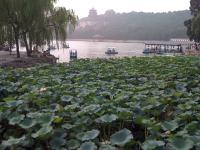 The famous Summer Palace was not only a UNESCO-inscribed World Heritage Site, and a place swarmed with tourists, it was also a park, where the locals went to relax. The vastness of it guaranteed plenty of paths for walking, and the proximity of the lake had a cooling effect. One could simply sit on a bench, eat green pea or red bean icecream, and watch people, or take a boat and cruise the lake. There were a number of interesting structures to visit, too (¥30-¥60). They had been a late addition to the city landscape (18th century), but had been built in a traditional style to match the much older imperial venues of Beijing.
The famous Summer Palace was not only a UNESCO-inscribed World Heritage Site, and a place swarmed with tourists, it was also a park, where the locals went to relax. The vastness of it guaranteed plenty of paths for walking, and the proximity of the lake had a cooling effect. One could simply sit on a bench, eat green pea or red bean icecream, and watch people, or take a boat and cruise the lake. There were a number of interesting structures to visit, too (¥30-¥60). They had been a late addition to the city landscape (18th century), but had been built in a traditional style to match the much older imperial venues of Beijing.
Cafe & Bar Berry, at 42 Sanlitun Street, the one with many bars and clubs, had Erdinger hefe weizen beer, both the light and dark versions (¥60, credit cards accepted) and had a good selection of okay wines and spirits. It was small and probably least sleazy than many of the bars/clubs in this area known for the many embassies. Just at the beginning of the street, by the Yaxiu Shopping Centre, Nigerian guys could secure a supply of any kind of stulating substances one would desire. They were really friendly and took refusal with grace and dignity, as well.
The street's bars-cum-clubs employed bands and singing groups to give 'live' performance to (doubtfully) pleasure the customers. Well, some of them were only slightly below average Idol's and X-Factor quality, whereas others just counted on their girl's attractiveness to do the trick. And it often worked!
|
Jul 29, 2009 02:00 PM Beijing (CN) - hmm... did the crowds ruin it for me?
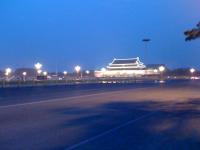 I am back in Beijing. Today, I went to the Forbidden City and Beihai Park, and did some walking around, ate Chinese dumplings and drank beer. I also had some spicy diced chicken with peanuts and hot chillies.
I am back in Beijing. Today, I went to the Forbidden City and Beihai Park, and did some walking around, ate Chinese dumplings and drank beer. I also had some spicy diced chicken with peanuts and hot chillies.
The Forbidden City (¥60) was so crowded that it was almost impossible to enjoy. I started from the Tiananmen Square and worked my way up north. Sections of the city were closed for visitors and parts of the gates were covered in green mesh for renovations. This was really disappointing as the tickets cost exactly the same as when all parts of the city would be open. I am not sure if there is a time if day when it would be best to see the complex to avoid the crowds. I went at noon, hoping the heat if the mid-day would have deterred many visitors. The imperial enclosure was packed with visitors, vast majority of whom were Chinese. As with them, who seemed to have no concept of curteousy, visiting monuments was exceptionally hard and really unpleasant. I did not last very long in the Forbidden City, also as most things looked much alike.
The Beihai Park was quieter, however far from deserted. It was a little less interesting than I thought, and I am not sure it was worth the price (¥30).
Today, weather was strange. It must have been the smog. The sun was shining, but it was not getting through a strange, grey mist hanging above the city. I snapped a few photographs but they are unlikely to be any good!
|
Jul 28, 2009 02:00 PM Datong (CN) - city with great history
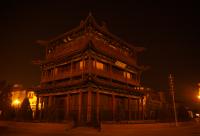 I had to get up early to catch my Beijing - Datong 07:30 am flight. Fortunately, the airport was only 30 minutes by taxi, and it was easy to call one from the street. I was a bit concerned about weather, as it was very foggy (smoggy?) flights might have been delayed. But that was nit the case. My flight left on time, and I landed in Datong, basking in sunshine, at 08:30 am. I quickly caught the airport shuttle (¥10) was at the hotel reception by 09:15 am. After having relaxed and eaten late breakfast (beef noodle), I embarked on discovering Datong country.
I had to get up early to catch my Beijing - Datong 07:30 am flight. Fortunately, the airport was only 30 minutes by taxi, and it was easy to call one from the street. I was a bit concerned about weather, as it was very foggy (smoggy?) flights might have been delayed. But that was nit the case. My flight left on time, and I landed in Datong, basking in sunshine, at 08:30 am. I quickly caught the airport shuttle (¥10) was at the hotel reception by 09:15 am. After having relaxed and eaten late breakfast (beef noodle), I embarked on discovering Datong country.
The receptionist, who barely spoke about ten words in English, insisted that it was just too difficult to go anywhere by public transport. I did want to cover a lot in a day, true. But I ambitiously claimed I could do it by bus. Actually, it was too late for that, and I was glad the hotel manager came and negotiated a car with a driver for me for the entire day. For a distance of 260 kilometres, I paid ¥340. I think that it was not a bad deal at all. This way, I managed to cover more in a day than I originally planned. It was a good day!
Datong in the Shanxi province, has over 2,300 years of great history. It had been the capital of the Northern Wei Dynasty, secondary capital of the Liao & Jin dynasties, and an important military centre of Qing & Ming dynasties. Yet, it does not sit very firmly among China's prime tourist destinations.
There are over 300 historical remains and sites of ancient relics, among which one has been listed by UNESCO as a World Cultural Heritage Site. They are the Yungang Grottoes, carved meticulously with Buddha images, dating back to 400s AD.
The street running south of the old Drum Tower was full of cafes that were humming with locals having their drinks, usually tea. Some of them looked triendier than others, some a little run down, I guess. But one could find Datongers in all sorts of them. I had a peek in a couple of them in the evening, and was under the impression that they really took their time, chatting rather loudly about... actually, I had no idea what about. I also liked an impromptu street night market, which developed right in front of my hotel. It did spawn a quick crowd, who came to check what was new and fashionable in the kitch and cheap (and completely silly and useless) toy department. I saw no-one actually buying anything. Datong was called the city of dragon walls, not just because of the unique Nine Dragon Wall. There were 4 One Dragon Walls; 1 Three Dragon Wall; 3 Five Dragon Walls; and one wall with circular 'dragon seals'.
|
Jul 28, 2009 02:00 PM Around Datong (CN) - discovering Shanxi's gems
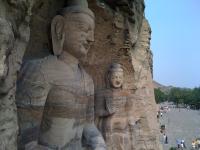 The Yungang Grottoes are the largest and earliest group of Buddha statues preserved in China. They are located at the foot of Mount Wuzhou, about 15 kilometres west of the centre of Datong city, and still within the suburbs. The group of 53 grottoes carved in solid rock stretch over 1 kilometre from east to west. The construction of the grottoes started at the time of the Northern Wei dynasty in 453 AD. They hold over 51,000 statues, the largest of which is more than 17 meters high, and the smallest is only 2 centimetres long.
The Yungang Grottoes are the largest and earliest group of Buddha statues preserved in China. They are located at the foot of Mount Wuzhou, about 15 kilometres west of the centre of Datong city, and still within the suburbs. The group of 53 grottoes carved in solid rock stretch over 1 kilometre from east to west. The construction of the grottoes started at the time of the Northern Wei dynasty in 453 AD. They hold over 51,000 statues, the largest of which is more than 17 meters high, and the smallest is only 2 centimetres long.
The site is visited mainly by Chinese travellers. I spotted only three other foreign-looking people, when I went. The public transport is rather difficult and the easiest way to get there is by taxi, which can be organised by the hotel, for a really good price. It should not cost more than ¥50, including waiting time.
I spent about an hour and a half over there, concentrating on the twenty largest and better decorated grottoes. And there were some awesome and huge Buddha statues! Entry was ¥60.
About 70 kilometres southwest from Datong, in Yingxian, there was the Wooden Pagoda, aka Sakyamuni Pagoda, part of the Fogong Temple (¥60). It was built in 1056 during Liao dynasty and had a total height of 67 metres with the diameter at the base of 30 metres. It claimed the title of the largest surviving wooden strcture tower building in the world. It was of an octagonal shape, and from the outside, it looked that it had five floors. In fact, there were four hidden levels inside, making the total nine floors. The pagoda was great indeed, but the entire town of Yingxian was exceptionally picturesque. For the first time on my entire trip, I really felt that I was in China! Traditional and looking very old houses with curved roofs lined all streets in the core of the town. Wherever I turned, I saw a temple-like building housing shops, banks, restaurants, or simply households. This was the greatest surprise of this holiday. I only found out about the place, after I arrived in Datong, and Yingxian appeared like a superb place to escape the world for a couple of days.
Again, some 70 kilometres away from Datong, in the south-westerly direction; about 40 kilometres east of Yingxian, there was the magnificent Beiyue Hengshan Hanging Monastery (entry: ¥60) This monastery was the very reason why I travelled to Datong at all. It is located on the west cliff of the Gold Dragon Gorge at the Hengshan Mountain, 5 kilometres south of Hunyuan. It was first built in 491 entirely of wood, based on half-inserted crossbeams, skilfully supported by hidden rocks to form a combination of rock and beam and column up and down, and a fixed match of the corridor and parapet, according to physical mechanics and gravity. It is considered a masterpiece and phenomenal example of the great knowledge of construction mechanics over 1,500 years ago! It is the only architecture on high cliff in China. Some freak twist of nature created rain at the temple. Everywhere else in the county there was plenty of sun! But right at the entry to the gorge, in those magnificent mountains, it just had to rain cats and dogs! What a strange twist of fate?! I was gutted! I was hoping to spend some time at the monastery and take plenty of pictures. Instead, climbing the cliff was risky as the path was slippery, and I had to borrow an umbrella from the taxi driver, so I could take just a few snaps. Such a shame! Well, at least I saw a lot more that day elsewhere.
|
Jul 27, 2009 02:00 PM Beijing (CN) - the Great Wall & more
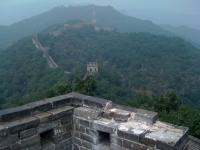 I decided to get a tour from the hostel to the Great Wall, the Mutianyu section, as the price was quite good (¥230) and I could pay with the credit card. I wrestled a little with the idea, as I do not like organised tours that much. Yet those organised by youth hostels tend to be better as young travellers go on them usually. The scheduled departure was 10:30 am, which was rather late for taking pictures, but it meant I could have a lie in after a late night socialising with the hostel guests from Sri Lanka, Spain, France, Argentina, Britain, and Malaysia. In the morning, to my great surprise, I found out that the tour, since it was Tuesday, was just for me and a lady from South Korea. We travelled in a nice limo driven by a crazy (in Chinese: normal) driver.
I decided to get a tour from the hostel to the Great Wall, the Mutianyu section, as the price was quite good (¥230) and I could pay with the credit card. I wrestled a little with the idea, as I do not like organised tours that much. Yet those organised by youth hostels tend to be better as young travellers go on them usually. The scheduled departure was 10:30 am, which was rather late for taking pictures, but it meant I could have a lie in after a late night socialising with the hostel guests from Sri Lanka, Spain, France, Argentina, Britain, and Malaysia. In the morning, to my great surprise, I found out that the tour, since it was Tuesday, was just for me and a lady from South Korea. We travelled in a nice limo driven by a crazy (in Chinese: normal) driver.
I got to the wall at noon and had two hours to climb the wall. It was a bit short, but since weather was not great for taking pictures, I did not cry. I knew I was going to Badaling on my own, probably on Friday, so kept it cool. I just disagreed with the guide that the Great Wall of China was not visible from space, actually. He did not argue, surprisingly. Also, he said the section of the wall to the right of the entrance was more scenic and less crowded than the left side. That was not true. The right side was shorter but steeper and, as a bonus, had a section closed for tourists, beyond which no restoration work had been done. It was not closed to me, and I ventured a few yards into the wild section of the wall, as it was overgrown with bushes full of bugs flying around, and it crumbled as I stepped on it. I think I liked the left side better though. It was more scenic, longer, and easier to climb. Actually, if I went on my own, I would have gone up with the cable car (the cabin car), walked the length of the wall, and then gone down by the other cable car (the seat on rope) or taken the skid (a bobsleigh-like on a metal chute).
I expected many more people to be visiting the wall. There were not that many at all. And the local merchants were not as aggressive as some reports had stated. Had weather been better, and had I drunk less beers the night before, it would have been a perfect day. Some sections were really steep. Sweat of the size of chicken eggs was dripping from my forehead and nose. I wish my sunglasses had automatic wipes!
After the climb, I had a spicy beef noodles and an egg pancake from the northern China. It was expensive (¥25), but hey, I was not going to come back there again...
Today, I also saw the Temple of Heaven, the Olympic Park and the Tiananmen Square.
|
Jul 26, 2009 02:00 PM Beijing (CN) - just arrived
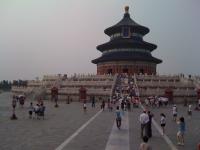 The flight from Nanjing to Beijing was on time. I managed to get into a VIP lounge again, which was great, as I could use a computer there, and posted a few photographs into the travel log. The machine was rather slow and globosapiens kept crashing (mind you, all mainstream social networks were banned in China when I visited) but just as I posted the last photo my flight was boarding.
The flight from Nanjing to Beijing was on time. I managed to get into a VIP lounge again, which was great, as I could use a computer there, and posted a few photographs into the travel log. The machine was rather slow and globosapiens kept crashing (mind you, all mainstream social networks were banned in China when I visited) but just as I posted the last photo my flight was boarding.
Uh, getting to the Nanjing airport was a bit tricky. I wanted to go on the airport bus again for the bargain ¥25 (€2.50) but I could not establish where the stop was. The coach made four stops in the city, one of which was rather near my hostel, but no-one knew where it was. The personnel at the international hostel did not speak any English when I was checking out, and was not particularly helpful in getting the information or even writing an instruction to a taxi driver. I had to use a translator application on my iPhone to communicate with a taxi driver, whom I took all the way to the airport for ¥120 (¥93 on the meter + ¥20 for the motorway toll) - not bad for a 40km ride. It took just over 30 minutes! And it was a good decision, yeah.
I was again unimpressed with the lack of consistency in quality of service on Air China flights. This flight from Nanjing to Beijing (I was yet again the only foreigner on the flight!) did not serve meals, like the flight from Xi'an to Chengdu. But the flights from Shanghai to Xi'an and from Chengdu to Nanjing did provide hot meal, the first flight even offered choice of beef or chicken! Staff on board was rather poor in English, although the ladies on the Shanghai to Xi'an flight were alright.
I'd like to make an observation that I felt like I was the only foreign traveller in China. At the Xi'an airport I spotted a couple of other Western travellers, but none at the Chengdu and Nanjing airports. It felt really weird as I was causing a major sensation with the check-in desk staff, with the sitting hostesses and waitresses at restaurants and a few shopkeeppers. I really expected to one of many and the only one. I wonder why this was. Perhaps I was travelling at a wrong season, which is probably it. Or maybe in China the Westerners chose to travel by train, and the locals by plane? Hmm...
The hostel was supposed to arrange for someone to pick me up at the airport (¥90) but they failed. I took a taxi instead (¥78), and only took half an hour. The 9 Dragon House was great. It had more of a feel for a hotel with plenty of ensuite rooms, where one was supplied with towels, soaps, shampoos, shower gels, toothbrush and toothpaste, toilet roll, shaving razor and cream, traveller's compressed towel to take, condoms (not yet sure about the size...;)), and a courious ancient Chinese medicinal lotion extending sexual pleasures, which came in two pouches, one exclusively for women, and one for men and it stated on the pouches that these should not be mixed up! The room was air-conditioned, had a phone, and a satellite TV.
|
Jul 26, 2009 02:00 PM Nanjing (CN) - 8 million people but city's still charming
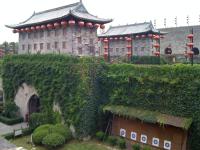 Well, at least bits of it. Nanjing had world's longest city wall. It was built during the Ming dynasty, when it was the capital of the Empire of China. The majority of the wall still stood when I visited. It was unusual, as it was not built in the square format like all city walls at that time (including those in Beijing and Xi'an). It zigzags (like traditional lake bridges) around the city taking advantage of the hills and canals. I thought that Xi'an's wall was enormous, and this one in Nanjing was even larger, although less complete. It had 13 gates, a few still stood when I visited. The largest, the Zhonghua Gate (¥25), had four rows of gates, where over 3,000 soldiers could station at the time of war or 1,000 permanently. The unique construction of the gate, its complexity and ingenuity made it a formidable defense system. And its size made it the largest city gate in the country. It was really impressive. However, I have to expose a fake. The three towers on top of the 3 intermediate inner gates were just wooden mockups. They were painted to look as if made of brick, though. I know this because I touched them!
Well, at least bits of it. Nanjing had world's longest city wall. It was built during the Ming dynasty, when it was the capital of the Empire of China. The majority of the wall still stood when I visited. It was unusual, as it was not built in the square format like all city walls at that time (including those in Beijing and Xi'an). It zigzags (like traditional lake bridges) around the city taking advantage of the hills and canals. I thought that Xi'an's wall was enormous, and this one in Nanjing was even larger, although less complete. It had 13 gates, a few still stood when I visited. The largest, the Zhonghua Gate (¥25), had four rows of gates, where over 3,000 soldiers could station at the time of war or 1,000 permanently. The unique construction of the gate, its complexity and ingenuity made it a formidable defense system. And its size made it the largest city gate in the country. It was really impressive. However, I have to expose a fake. The three towers on top of the 3 intermediate inner gates were just wooden mockups. They were painted to look as if made of brick, though. I know this because I touched them!
The area around the Fuzi Temple, aka ancient Confucian Temple, tightly built up in the combination of Ming and Qing dynasties styles, was my favourite part of this giant city. No traffic could be heard as the entire area, including a large portion of the immediate neighbourhood was car free. Wandering around the cafes and souvenir shops selling an ocean of colourful things ranging from miniature golden statues to colourful china teapots, cups and chars to almost glowing silk shirts to glass jewelry to wooden fans to great swords. I was tempted several times.
The Bailuzhou Park (¥20) was a pleasant spot in town surrounding a small lake. It had the Huiguang Temple (1431) with White Pagoda called The Egret Tower within its premises and the Juifeng Temple, which was frequented by worshipers. In the wooden cabins dotted around the lake, local people played instruments, sang, played games, some exercised.
The Jianguan Imperial Examination School (¥20) was amongst the most photographed by the local tourists sights in Nanjing. It was founded in 1168 by Emperor Qiandao. It was the country's largest examination site with 20,644 students.
Now, I will be on my way to Beijing. I hope I built up enough expectations for the sights there and the Great Wall!
|
Jul 25, 2009 02:00 PM Nanjing (CN) - duck's no good for me
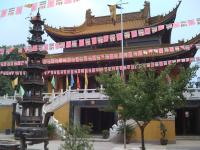 I wandered a little about Fuzimiao district looking for an authentic restaurant. The thing was that all restaurants and cafes were busy with local people only. I was the only foreign tourist in the city, it seemed, causing a bit of a sensation.
I wandered a little about Fuzimiao district looking for an authentic restaurant. The thing was that all restaurants and cafes were busy with local people only. I was the only foreign tourist in the city, it seemed, causing a bit of a sensation.
Pan Chi Jiu was a cafe I stumbled upon on one of the pedestrianised streets. I ordered the Nanjing duck and was shocked it was served cold! It was salty (it was supposed to!) and boney. I didn't like it. I also ordered a soup, which arrived in humongous quantities. It was a mistake. I paid ¥50, which by Chinese standards was expensive.
Then, for dinner I found this magnificent little curry place called Curry Haunt. It was behind the Mandarin Garden Hotel. No English was spoken and no English menu was available. A diner there helped me to order nice and spicy chicken curry (¥16). I asked about duck curry, but that was not possible. My curry was perfect! And this way I avoided eating at Burger King, which I was seriously considering after the disasterous lunch!
|
Jul 24, 2009 02:00 PM Nanjing (CN) - city that was China's capital six times!
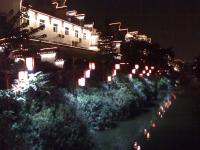 My flight to Nanjing was delayed for a number of contradicting reasons, and I won't simply go there. So, annoyed with so many Air China employees, and me being cheeky, I blagged my way into their VIP lounge by waving my expired Star Alliance Gold Card. Air China is a relatively new member of the Star Alliance, and clearly they did not understand all if the processes. I spotted this opportunity in Shanghai, where upon check-in I was told to proceed to the first class check-in desk to obtain a lounge pass. I suspected their must have misread my card validity (I do not have my new card yet, and I dropped to the Silver level), but did not bother then. I am not sure how the lounge was in Shanghai and Xi'an, but this one in Chemgdu had no booze. Just crackers, rice cakes, and soda drinks, uh and teas, obviously.
My flight to Nanjing was delayed for a number of contradicting reasons, and I won't simply go there. So, annoyed with so many Air China employees, and me being cheeky, I blagged my way into their VIP lounge by waving my expired Star Alliance Gold Card. Air China is a relatively new member of the Star Alliance, and clearly they did not understand all if the processes. I spotted this opportunity in Shanghai, where upon check-in I was told to proceed to the first class check-in desk to obtain a lounge pass. I suspected their must have misread my card validity (I do not have my new card yet, and I dropped to the Silver level), but did not bother then. I am not sure how the lounge was in Shanghai and Xi'an, but this one in Chemgdu had no booze. Just crackers, rice cakes, and soda drinks, uh and teas, obviously.
From this now on, I will try this trick in all other airports, and I am really curious what will happen in Beijing, where I expect things to be more up-to-date.
Although I was considering Nanjing for my initial holiday plan, I eventually dropped it from my itinerary as it did not fall into a logical route. However, since the Tibetan leg of my holiday failed miserably (following the gross incompetence and perhaps unwillingness to assist of travel agents in Shanghai and one in Chengdu), I had to change my plans, and re-routed my flights to Nanjing. Which was very easy and took only two minutes.
Apparently, Nanjing was famous for duck dishes, which were made in a special way. Chengduanians were envious that I would have an opportunity to try duck in Nanjing. I made a promise myself to make an effort therefore to go for it. Tomorrow.
I took a stroll in Fuzimiao district of Nanjing at night, after I arrived. It was great. Red paper lamps hanging from roofs of traditional Chinese architecture, reflected in the waters of the canals made me happy. I discovered two pedestrianised streets just yards away from my hostel (Nanjing Fuzimiao International Hostel) full of shops, cafes and eateries. I think I will be happy here! Well, I will see how things will develop tomorrow. I am still to discover what to see in this city.
|
Jul 23, 2009 02:00 PM Chengdu (CN) - the Giant Panda
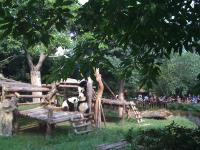 I had to get up quite early in the morning for the trip to the Giant Panda Breeding Centre. I wanted to make sure I was going to make it for the feeding time, and before it got too hot for the animals, who usually just hide away in their air-conditioned enclosures and sleep all day.
I had to get up quite early in the morning for the trip to the Giant Panda Breeding Centre. I wanted to make sure I was going to make it for the feeding time, and before it got too hot for the animals, who usually just hide away in their air-conditioned enclosures and sleep all day.
It was good. I saw three adult Giant Pandas just layzing on wooden platforms, five or six one-year-old Giant Panda cubs playing around, and six or seven Red Pandas. This is how the centre was split - three enclosures. By 2010, theentire centre will have been enlarged significantly to create almost an entertainment park that will surround the research centre. Today, I saw the nursing of the panda infants, an educational pavillion containing facts of the Giant Panda and its history and evolution, and a cinema showing a film about the pandas and the breeding programme.
The rest of the day I spent on walking. I visited a few temples and parks, and the former home of the poet DuFu. It was lovely! Had I lived in such beautiful garden and surroundings, which must have been even prettier in the 8th century, that even I would easily have written beautiful poetry, although I found DuFu's poems a little too patronising and perhaps pretentious. But that's me! I'm sure there are millions of people, who adore DuFu's work.
I did not intend to walk the entire city's length and width, but as it happened, it was impossible to decypher the bus network, I didn't learn enough Chinese to ask for directions, the Suchuanians didn't speak any foreign language, and taxis simply refused to stop for me. I stopped in a couple of parks, including the People's Park to relax over China's green teas (very expensive - from ¥10-¥30 (€1-€3), and promised myself that I would not stop enroute for dinner, but will eat at the Tibetan quarter to substitute for the lost trip to Lhasa. This meant that I had to walk during the hours of darkness in a humongous city without a decent map (I took a wrong turn twice!), until I got near my hostel. Strangely, all that adrenaline meant that I was not even tired, or perhaps it was the magical effects of tea!
Today has been a better day than the recent few! It wasn't perfect, and ought to have been better but the imperfections have been immaterial in the all schema of things.
|
Page:
 34 35 36 37 38 39 40 41 42 43 44
34 35 36 37 38 39 40 41 42 43 44

|
|
|
